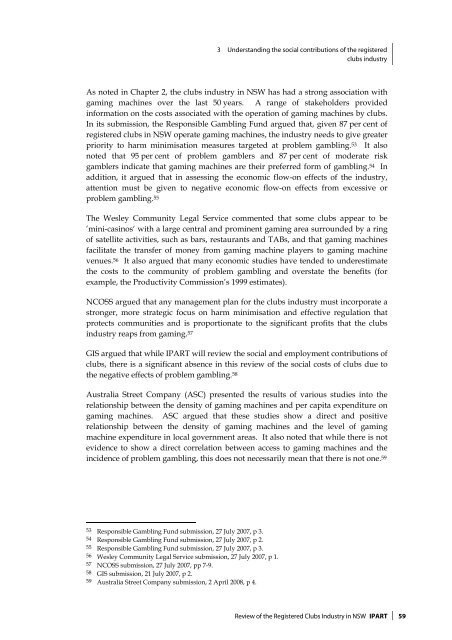Review of the Registered Clubs Industry in NSW - Clubs NSW
Review of the Registered Clubs Industry in NSW - Clubs NSW
Review of the Registered Clubs Industry in NSW - Clubs NSW
You also want an ePaper? Increase the reach of your titles
YUMPU automatically turns print PDFs into web optimized ePapers that Google loves.
3 Understand<strong>in</strong>g <strong>the</strong> social contributions <strong>of</strong> <strong>the</strong> registered<br />
clubs <strong>in</strong>dustry<br />
As noted <strong>in</strong> Chapter 2, <strong>the</strong> clubs <strong>in</strong>dustry <strong>in</strong> <strong>NSW</strong> has had a strong association with<br />
gam<strong>in</strong>g mach<strong>in</strong>es over <strong>the</strong> last 50 years. A range <strong>of</strong> stakeholders provided<br />
<strong>in</strong>formation on <strong>the</strong> costs associated with <strong>the</strong> operation <strong>of</strong> gam<strong>in</strong>g mach<strong>in</strong>es by clubs.<br />
In its submission, <strong>the</strong> Responsible Gambl<strong>in</strong>g Fund argued that, given 87 per cent <strong>of</strong><br />
registered clubs <strong>in</strong> <strong>NSW</strong> operate gam<strong>in</strong>g mach<strong>in</strong>es, <strong>the</strong> <strong>in</strong>dustry needs to give greater<br />
priority to harm m<strong>in</strong>imisation measures targeted at problem gambl<strong>in</strong>g. 53 It also<br />
noted that 95 per cent <strong>of</strong> problem gamblers and 87 per cent <strong>of</strong> moderate risk<br />
gamblers <strong>in</strong>dicate that gam<strong>in</strong>g mach<strong>in</strong>es are <strong>the</strong>ir preferred form <strong>of</strong> gambl<strong>in</strong>g. 54 In<br />
addition, it argued that <strong>in</strong> assess<strong>in</strong>g <strong>the</strong> economic flow-on effects <strong>of</strong> <strong>the</strong> <strong>in</strong>dustry,<br />
attention must be given to negative economic flow-on effects from excessive or<br />
problem gambl<strong>in</strong>g. 55<br />
The Wesley Community Legal Service commented that some clubs appear to be<br />
’m<strong>in</strong>i-cas<strong>in</strong>os‘ with a large central and prom<strong>in</strong>ent gam<strong>in</strong>g area surrounded by a r<strong>in</strong>g<br />
<strong>of</strong> satellite activities, such as bars, restaurants and TABs, and that gam<strong>in</strong>g mach<strong>in</strong>es<br />
facilitate <strong>the</strong> transfer <strong>of</strong> money from gam<strong>in</strong>g mach<strong>in</strong>e players to gam<strong>in</strong>g mach<strong>in</strong>e<br />
venues. 56 It also argued that many economic studies have tended to underestimate<br />
<strong>the</strong> costs to <strong>the</strong> community <strong>of</strong> problem gambl<strong>in</strong>g and overstate <strong>the</strong> benefits (for<br />
example, <strong>the</strong> Productivity Commission’s 1999 estimates).<br />
NCOSS argued that any management plan for <strong>the</strong> clubs <strong>in</strong>dustry must <strong>in</strong>corporate a<br />
stronger, more strategic focus on harm m<strong>in</strong>imisation and effective regulation that<br />
protects communities and is proportionate to <strong>the</strong> significant pr<strong>of</strong>its that <strong>the</strong> clubs<br />
<strong>in</strong>dustry reaps from gam<strong>in</strong>g. 57<br />
GIS argued that while IPART will review <strong>the</strong> social and employment contributions <strong>of</strong><br />
clubs, <strong>the</strong>re is a significant absence <strong>in</strong> this review <strong>of</strong> <strong>the</strong> social costs <strong>of</strong> clubs due to<br />
<strong>the</strong> negative effects <strong>of</strong> problem gambl<strong>in</strong>g. 58<br />
Australia Street Company (ASC) presented <strong>the</strong> results <strong>of</strong> various studies <strong>in</strong>to <strong>the</strong><br />
relationship between <strong>the</strong> density <strong>of</strong> gam<strong>in</strong>g mach<strong>in</strong>es and per capita expenditure on<br />
gam<strong>in</strong>g mach<strong>in</strong>es. ASC argued that <strong>the</strong>se studies show a direct and positive<br />
relationship between <strong>the</strong> density <strong>of</strong> gam<strong>in</strong>g mach<strong>in</strong>es and <strong>the</strong> level <strong>of</strong> gam<strong>in</strong>g<br />
mach<strong>in</strong>e expenditure <strong>in</strong> local government areas. It also noted that while <strong>the</strong>re is not<br />
evidence to show a direct correlation between access to gam<strong>in</strong>g mach<strong>in</strong>es and <strong>the</strong><br />
<strong>in</strong>cidence <strong>of</strong> problem gambl<strong>in</strong>g, this does not necessarily mean that <strong>the</strong>re is not one. 59<br />
53 Responsible Gambl<strong>in</strong>g Fund submission, 27 July 2007, p 3.<br />
54 Responsible Gambl<strong>in</strong>g Fund submission, 27 July 2007, p 2.<br />
55 Responsible Gambl<strong>in</strong>g Fund submission, 27 July 2007, p 3.<br />
56 Wesley Community Legal Service submission, 27 July 2007, p 1.<br />
57 NCOSS submission, 27 July 2007, pp 7-9.<br />
58 GIS submission, 21 July 2007, p 2.<br />
59 Australia Street Company submission, 2 April 2008, p 4.<br />
<strong>Review</strong> <strong>of</strong> <strong>the</strong> <strong>Registered</strong> <strong>Clubs</strong> <strong>Industry</strong> <strong>in</strong> <strong>NSW</strong> IPART 59
















